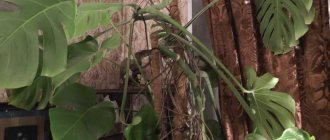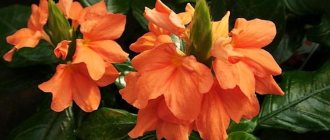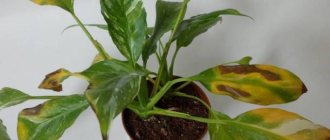Monstera is a deciduous plant from the aroid family, absolutely unpretentious in maintenance. If you care for it correctly, it becomes a real decoration of the house and reaches a height of 3-4 meters. However, its owners often encounter problems in growing it, which can be easily overcome with certain knowledge.
Leaves begin to turn yellow
This happens with insufficient nutrition. Store-bought fertilizers will help get rid of this problem.
Yellowing may also indicate excessive soil moisture. Under these circumstances, stop watering for a while until the plant recovers.
Other similar lesions of Monstera occur due to diseases such as chlorosis or fusarium. In the first case, iron chelate from a flower shop will help. In the second case, there is no specialized treatment. It is necessary to limit watering, otherwise the plant may die.
How to properly care for monstera at home
Monstera is a fairly large indoor plant with large dark green leaves that have slits on both sides. Its name translated from Latin means “unusual, strange, amazing.” In another way, monstera is also called philodendron or “crybaby”.
Homeland of monstera and its species
The monstera is native to the tropical forests of Eastern India and Central America. In nature, they are vines reaching a length of 30-40 meters. The diameter of the leaves of such plants can reach up to a meter. In nature, Monstera blooms and bears fruit. Monsteras domestica rarely bloom and do not bear fruit.
Among indoor monsteras, there are two main varieties:
- Monstera attractive, or delicacy, is a plant with large, leathery, dark green, rugged leaves. Young leaves appear whole and light; with age they darken and acquire cuts. In this form there are plants whose leaves have light spots or stripes;
- Monstera unequilateral, or oblique, is a more compact plant with asymmetrical leaves with oblong holes on both sides.
Monstera is quite whimsical and requires careful care with strict adherence to certain rules. Otherwise, the plant will begin to wither and lose its attractive appearance.
Watering monstera
In spring and summer, the plant requires abundant watering , for which it is better to use soft, settled water. In autumn, watering is reduced to moderate; in winter, the plant is watered approximately two days after the top layer of soil has dried. But at any time of the year it is useful to periodically spray monstera leaves with soft water at room temperature.
You should not overfill the monstera with water - otherwise its leaves will begin to rot and become covered with dark spots. But the soil should not be allowed to dry out.
Lighting requirements
In principle, Monstera tolerates shaded places, but it is best to choose a place for it where it will be in partial shade or illuminated by diffuse, indirect light. The monstera does not tolerate strong shadow or, on the contrary, direct bright sunlight at all.
Monstera does not like frequent movements , so it is best to choose a place for it right away so that you do not have to constantly move the pot. At home, it is best to place this plant near a western or eastern window.
Temperature regime for monstera
Active growth of monstera begins at a temperature of 16-18 degrees Celsius, but the optimal temperature for it is considered to be approximately 25 degrees. However, the monstera tolerates small temperature changes relatively easily, but its growth slows down. In winter, it is better not to let the temperature drop below 12 degrees.
Optimal air humidity
Monstera, like most tropical plants, loves humidity. Therefore, it is necessary to regularly spray it with water at room temperature, otherwise the leaves will begin to dry out. But in winter, if the room is too cold, it is better to refrain from spraying.
Fertilizer and feeding of monstera
Young plants do not need to be fed, but adult monsteras should be fed with mineral and organic fertilizers regularly - from April to August every two weeks. If this is not done, the monstera will stop growing, the leaves will become dull and small. In addition, adult plants need support ; For this you can use grids, sticks, ropes or special supports available on the market.
How to propagate monstera
Monstera can be propagated at home in several ways. It is preferable to use rooted cuttings and cut off tops (when pruning). Seed propagation is also possible if you can obtain seeds of a certain type or variety.
Propagation by cuttings
Propagating monstera by sections of the stem with 2-3 small leaves is the easiest and most affordable way at home. Cuttings cut from an adult plant are rooted in water or wet sand. After 6–8 weeks at a temperature of about 25°C, young roots form. If the monstera has become bald, then cut the shoot into sections with aerial roots and at least one leaf. Root in the same way as described above.
Reproduction by layering
Another reliable way to propagate monstera is using lateral shoots with aerial roots. They are placed in a pot with nutritious soil and secured with a support or improvised means. As the cuttings begin to grow, young leaves will appear. The rooted shoot is cut off from the mother plant and installed in a permanent place.
Types of monstera - photos and names of indoor varieties
What monsters look like in a room largely depends on the type and variety. Some tend to stretch out more, while others create a massive, wide bush. Maintenance conditions and proper care of plants are also important.
In nature, there are numerous species of monstera: according to some sources - 31, according to others - about 50 or 60. Much fewer are used in culture.
Attractive or delicious (monstera deliciosa)
The delightful Monstera - Monstera deliciosa (Family Araceae) - is the most common species in indoor culture. The name is often pronounced as “attractive monstera.” Sometimes the specific term “Monstera deliciosa” or dainty is used, which indicates the edibility and fruity taste of the fruit.
Features of Monstera deliciosa:
- the leaves of young plants have entire edges, then they become shield-shaped and take on a deeply cut shape (in the photo above, various variants of leaves are clearly visible);
- the color is initially light green, changing over time to a glossy dark green;
- the leaves of an adult plant are leathery, perforated and deeply dissected, up to 50 cm in size;
- the petioles are unusually long and strong, often inclined downwards, which allows the powerful leaves to rest on the branches of other plants;
- a large inflorescence appears on old specimens with good care, comparable in size to an ear of corn;
- edible fruits with the smell of pineapple;
- when air humidity increases, special veins release droplets of juice;
- The “crying” of monstera is a natural barometer that predicts the onset of precipitation a day in advance.
The varieties Borziga and Borsitjiana were bred from the tasty monstera. They are very similar. The main difference in cultivation is the creeping pattern. If Monstera deliciosa tends to grow in width, then Borsigiana stretches upward. The photo illustrates these differences well:
The compact monstera "Borziga" is suitable for small spaces. The typical climbing plant is slow growing. The leaves are smaller (up to 30 cm in size) than those of Monstera delightful and have fewer holes.
Other beautiful varieties of Monstera deliciosa are the variegated “Variegata” with a creamy white leaf pattern:
- "Albo variegata" - with white spots of irregular shape;
- "Aura variegata" - green leaves with yellow or beige highlights and stripes.
Alba variegata
Monstera "Alba" and other variegated varieties grow slowly, are especially sensitive to lack of heat, light and moisture, and rarely bloom and bear fruit indoors. When kept in the shade, the leaves lose their variegated color and become completely green.
Monstera adansonii
The small vine monstera adansonii with delicate, “holey” heart-shaped or elliptical leaves differs significantly from the varieties listed above. Monstera adanson can be grown as a hanging plant in a hanging basket, planter or in a regular flower pot on a high shelf.
The vine is placed near a window so that bright, but not direct sunlight falls on the leaves.
The edges of the leaf blades of young specimens of M.adansonii are usually without grooves or patterns. The appearance of elongated holes is characteristic of mature plants.
Variegata monstera - Monstera adansonii "Variegata" - is a compact variety with beautiful spotted leaves. They are oval or irregular in shape, half green, half cream, or with large spots throughout the leaf blade.
Monstera variegated does not tolerate a lack of moisture and light.
Monstera obliqua
One of the rarest species among other representatives of its botanical genus. Monstera obliqua is a vine up to 2 m long. The main difference from Monstera adansonii is strong perforation. There are more holes than a sheet! In fact, 80–90% of the leaf blade consists of holes of various shapes and sizes.
Monstera oblique is rarely found in garden centers or flower shops. Sellers offer Monstera adanson, claiming that it is M. oblique. It is difficult to keep Monstera obliqua indoors due to the need to maintain constant and significant humidity - 85% and above.
There is a species of monstera thin - Monstera tenuis. The species is common in South America, but is rarely found in cultivation. Compact vine with a thin stem and graceful shoots. Young leaves are entire or slightly dissected. In adulthood, the leaf blades are openwork. Another rare species is Monstera Friedrichstahl. Found naturally in the tropics of Costa Rica.
Symptoms of monstera disease
Obvious symptoms of plant diseases are yellow or darkened leaves, the appearance of spots on them, drying out of the edges and their curling. Pay attention to the following signs:
- pale color and round holes - direct sunlight hits the plant and burns it, move the pot to partial shade;
- pale color – there are not enough microelements, the flower needs to be fertilized with a special fertilizer;
- rotting - excess moisture or too low air temperature, limit watering and place the monstera in a warmer place.
Why are scientists interested in the holes on monstera leaves?
However, these slits not only delight our eyes, but have also confused scientists for a long time. Until recently, botanists could not understand why monstera leaves need these holes. A variety of hypotheses have been put forward:
- that supposedly these holes help plants resist the pressure of the wind,
- or they are needed to regulate the temperature of the plant and the amount of water in it.
Some even suggested that the holes in the leaves help monsteras hide from herbivores.
Monstera transplant
Young, constantly growing monsteras need to be replanted every year. Adult plants do not need such frequent replanting; it can be done once every 3-4 years, changing only the top layer of soil annually.
For replanting, use the following soil composition: two parts of turf and one part each of purified sand, humus and peat soil.
Monstera should be planted in sufficiently spacious containers. For young plants, buckets are often used instead of pots; for older plants, large pots or wooden tubs are used.
When replanting, you should not remove the aerial roots that form on the monstera stems. With their help, the plant receives additional moisture from the air. These roots need to be tied so that they are directed towards the ground - then they will gradually take root in the soil and produce new shoots.
After replanting, you can trim the top of the old plant so that the side shoots grow more actively. Young plants do not need such pruning.
Monstera reproduction
Monstera, like other members of the aroid family, is best propagated by cuttings. But you can use other methods of propagation - by seeds or shoots.
When monsteras are propagated by seeds, they are sown in a bright, warm room. Shoots appear in 2-4 weeks. The process of caring for seedlings includes picking, planting in pots and replanting every year. However, this method of propagating monstera is very labor-intensive, complex and rarely used.
A more popular method is propagation by cuttings and shoots. It is produced between March and June. For this, lateral shoots that grow in the lower part of each stem are used, as well as apical or stem cuttings, which are a stem fragment with one or two leaves. The cuttings are planted in a separate container filled with drainage and a mixture of sand and peat soil, after which they are covered, for example, with a glass jar to create a greenhouse effect.
The optimal temperature for growing monstera cuttings is 20-25 degrees Celsius; they need to be watered twice a day - morning and evening.
After the cuttings have given their own roots, they are transplanted into intermediate containers, and after 3-4 years, when the young plant has already fully developed, it is planted in a spacious tub or pot.
Prevention and care measures
To prevent diseases and pest infestations, follow the following rules:
- buy plants in a specialized store - the likelihood of purchasing a diseased monstera is much lower, and you can get advice on care from a specialist;
- observe quarantine for new flowers for at least a week, only after that place the pots next to others;
- periodically wash the leaves with Epin or Zircon;
- From time to time, disinfect the soil with a weak solution of potassium permanganate and fertilize the soil;
- Provide good care to the plant in accordance with its requirements.
Inspect your flower every week to spot any signs of problems as early as possible. The unpretentious monstera has a strong immune system if it receives enough minerals, water and light. Follow simple rules for caring for it and do not forget that they are different in summer and winter.
—Categories
- Nature (11)
- Gardening (5)
- Houseplants (1)
- My garden (6)
- My garden (5)
- Animals (1)
- Pets (1)
—Search by diary
—Subscription by e-mail
—Interests
— Regular readers
-Statistics
Sunday, January 08, 2022 21:26 + to quote book
1.
2.
3.
4.
5.
Problems of growing monstera
- Monstera leaves are small, not cut, on long petioles - juvenile leaves should be like this on the tops of the shoots), but if such leaves are on the entire stem - this is a lack of light, you need to move the plant to a more illuminated place.
- Monstera leaves turn yellow - with large-scale yellowing, the cause may be waterlogging of the soil, this is especially dangerous in winter at low temperatures in the room (balcony), due to strong dampness the leaves also become soft and hang like rags. With a lack of nutrition, the leaf turns yellow gradually, from the tip. Check the soil - loosen the top layer of soil as much as possible and touch the soil in the depths of the pot. If too wet, loosen deeper. When the shoots of a plant become limp from dampness, all that remains is to cut off the branches and re-root.
- The leaves turn yellow and dry brown spots appear on them - with insufficient watering or when it is too hot and dry (in winter during the heating season). Check the soil, if it is very hot and dry, you need to water more often.
- If brown spots along the entire edge of the leaf, like a border, this is a lack of potassium, it happens in old plants that have not been replanted for a long time.
- The leaves are pale transparent, become gray, then turn brown - with excess sunlight, burns in the spring on sunny windows are especially dangerous.
- The bare lower part of the trunk or stem, small leaves, poorly cut, long internodes - an acute lack of lighting, although over time the plant tends to lose leaves in the lower part of the stems.
- Yellowing or drying out of leaves can also be caused by pests - inspect the leaves from all sides, especially the back side, preferably with a magnifying glass.
Symptoms of diseases
There are several symptoms that may indicate that your pet is sick. Many of these signs indicate not only illnesses, but also insufficient care of the plant.
Dark spots
In certain cases, dark spots on the leaves of vines are evidence that the plant is cold. To correct the situation, the location of the vine is changed to a warmer one.
In addition, the formation of dark spots on the leaves is often a consequence of the plant being too waterlogged. In this case, it is necessary to check the root system for the formation of rot.
If rot has already appeared, it is carefully cleaned off, and the bare areas are covered with activated carbon, dried, and transplanted into renewed soil.
Also, monstera leaves turn black in heavy soil, through which the passage of air is difficult. The soil, compacting during watering, deprives the vine's root system of the ability to breathe normally. Here, an effective solution to this problem would be to replace heavy soil with lighter soil. To do this, you can mix the soil with purchased soil for houseplants.
The leaves are turning yellow
Monstera leaves turn yellow for several reasons. In winter, the “pet” is especially sensitive to heavy watering and lack of full sunlight. In this case, the lower leaves of the vine begin to turn yellow first. To improve the health of the plant, it is necessary to reduce the number of waterings and install it in the brightest place or organize additional lighting.
The frequency of watering is directly dependent on the air temperature in the room. For example, if the mark on the thermometer does not rise above 16 degrees Celsius, then watering should be done approximately once every two weeks. When watering, use water at room temperature.
After watering, pay attention to the accumulation of water in the pan - after 20 minutes, be sure to drain the excess water. Otherwise, constant contact of the vine roots with water can cause them to rot.
If monstera leaves turn yellow randomly, this indicates prolonged exposure to ultraviolet rays. In order to correct the situation, you just need to choose a more comfortable illuminated place for the plant, but without direct exposure to ultraviolet radiation.
The edges are drying
The edges of the leaves dry out due to insufficient watering and dry air. To solve this problem, you need to pour expanded clay into a wide tray, fill it with water, and place the pot on the expanded clay. Moisture from the expanded clay will gradually evaporate and humidify the air. If it is not possible to use this method, you can use a humidifier or place an open container of water near the monstera.
Brown spots
Brown spots on monstera leaves can be the result of burns. In this case, the damaged leaves must be removed, and for the vine, choose a more shaded place, move it away from the window or curtain it.
The appearance of irregularly shaped brown spots with yellowish edges may indicate damage to the root system by a fungal infection due to a whole complex of unfavorable factors: waterlogging, low temperature and insufficient lighting.
To save and treat monstera from fungus, the plant is transplanted into renewed soil, having first removed the damaged roots, and the cuts are sprinkled with coal dust. The pot must be selected according to the size of the flower.
In a pot that is too large, there is a high risk of overwatering the plant and disrupting the air channels to the roots. The first watering after transplantation must be done after the top layer of soil has dried 2 cm. In this case, it is better to use the special antifungal drug “Fitosporin”, diluted in accordance with the instructions on the package.
Care Tips
One of the main conditions for caring for monstera is to protect it from drafts and mechanical damage.
Monstera diseases and pests
If you care for the monstera correctly, it very rarely . Most of its diseases are associated with a violation of temperature or air humidity - for example, leaves may begin to rot or, on the contrary, dry out, and new leaves grow dull and small. This may also indicate a lack of nutrition if the plant is not regularly fed.
However, pests do not ignore the monstera either. The fact that a plant is affected by some pest can be understood by its appearance and the correct method of treatment can be selected.
- Spider mites infest plants if the air in the room is dry enough. The defeat is indicated by the loss of a significant part of the leaves by the monstera. To get rid of the pest, the plant should be sprayed with warm water and the leaves should be thoroughly washed with soapy water. When the leaves dry after the procedure, treat the plant with an insecticide.
- If a monstera is infected with thrips - microscopic pests invisible to the naked eye - light spots and dots appear on its leaves, which gradually expand, occupying almost the entire surface of the leaf, and it becomes dirty gray. In this case, the plant should also be treated with an insecticide (intavir, actellik, etc.).
- Scale insects are small insect pests belonging to the suborder Coccidae. If they attack a plant, its leaves become limp, lose color and fall off over time. To combat these insects, the plant must be cleaned of pests by wiping each leaf with soapy water and a sponge, and then treated with an insecticide dissolved in water.
- The mealybug is a close relative of the scale insect. It sucks the juices out of the plant, as a result of which the monstera may begin to shed its leaves. To combat mealybugs, the plant should also be thoroughly washed with soapy water and then sprayed with an insecticide.
Monstera flower: botanical description
Monstéra is a large tropical plant that looks like a vine and belongs to the Araceae family. Under natural conditions it grows in Brazil and the equatorial belt of America, and loves the conditions of the humid tropics. It is mistakenly believed that Monstera is a palm tree. In fact, this evergreen vine has large carved leaves up to 40-45 cm long.
All species are quite unpretentious, but in order to get a large and highly decorative plant at home, a monstera stick is used, which is a stable and reliable support. The foliage is pinnately dissected and perforated. Flowers are collected on cobs. The flowering plant lasts for a long time, after which it forms berries and fruits.
Homeland of indoor monstera
The homeland of the perennial is considered to be tropical forest zones in South and Central America, as well as some areas of Brazil and Mexico, as well as Costa Rica, Guatemala and Panama.
How does monstera bloom and where does it grow?
In indoor cultivation, the liana blooms annually , after which edible, relatively small fruits can be formed, which resemble pineapple in taste and aroma. Monstera flowers are quite beautiful and are represented by greenish cobs, wrapped in a dense snow-white blanket. Inflorescences most often form at the base of the plant.
Causes of blackening of monstera leaves
Monstera leaves turn black. Why does this happen, since all the conditions for keeping the flower are met? The leaves of a flower can turn black due to waterlogging of the soil. In addition, the plant is planted in too heavy soil. When watering, it sticks together and does not allow air to pass through to the roots, which affects the condition of the leaves. Regular waterlogging of the soil and insufficient oxygen saturation of the soil leads to disruption of the root system. The problem can be solved by adjusting the watering. After the monstera begins to expel new leaves and the old ones stop turning black, you can think about replanting. Light soil is used for this.
Why else do monstera leaves turn black? If the tips of the leaves of a plant do not turn black, but the leaf blade becomes covered with spots, this indicates the presence of parasites on the flower. First of all, experts point to the scale insect. As a result of its vital activity, it releases honeydew. This is a sugar solution on which sooty fungus readily settles. Black spots are colonies of fungi. The reason for the appearance of black spots on the monstera is the scale insect. Control measures: be sure to isolate the flower and treat it with fungicides.
Why do monstera leaves turn black and yellow? The leaves grow small. Before they have time to open, they turn black at the tips, and the trunk of the plant becomes wrinkled. Cause of the disease: waterlogging of the soil. This happens either from too frequent watering, or the flower pot is very large and the root system does not have time to absorb all the liquid from the soil. If the tips of the leaves of the plant simply turn black, then you can save it by normalizing watering. If a monstera's stem has shriveled and rotted, the flower cannot be saved. You can cut it for rooting.
Is it possible to keep a monstera at home?
Some people wonder why you can’t keep a monstera at home? Of course you can, this wonderful plant has more positive properties, judge for yourself, proven facts:
- Pros: Monstera purifies the air and moisturizes it, and very significantly, due to the large leaf mass. Optimizing the microclimate activates brain activity and makes breathing easier.
- Cons: monstera sap is poisonous, it is necessary to keep it away from small children and handle the plant correctly (wash your hands after replanting and pruning).
Folk signs (unproven versions): Monstera deliciosa (attractive) should not be kept in the bedroom, as it supposedly sucks energy from sleeping people at night. At the same time, another belief says that a monstera in the house is able to smooth out conflicts, neutralize “vampirism” in a person and filter negative emotions. In some Latin American countries there is a saying: if you have a headache, sit next to a monstera and this will significantly ease the condition.
Advice from iplants.ru: Monstera is ideal for living rooms and other spacious rooms, and brings cleanliness, freshness, comfort, harmony and positive active energy to the house.











